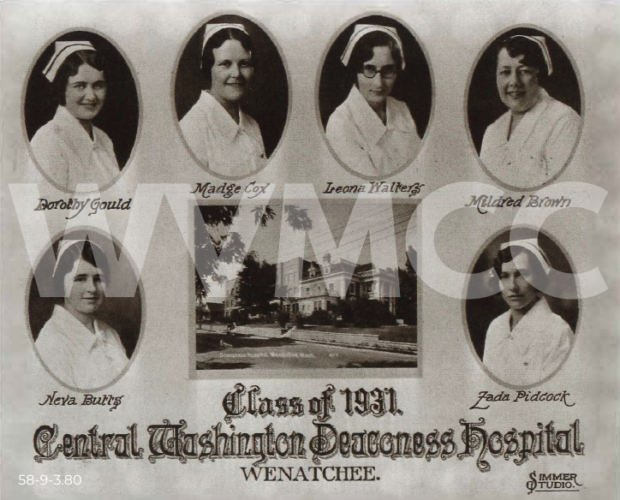Hospitals Cared for Early Wenatchee Valley Residents – 6/13/2024
Source: Wenatchee Valley Museum & Cultural Center #58-9-3.80. Both Deaconess and St. Anthony’s Hospitals had fine nursing schools. During its 53 years of operation, the Deaconess school graduated more than 300 nurses. An excellent nursing program is now offered at Wenatchee Valley College, along with other medically related courses of study.
Written by Chris Rader
Wenatchee’ s and Leavenworth’s earliest hospitals were opened by pioneer doctors who made do with simple facilities. The first of these makeshift hospitals were in the homes of Dr. George Hoxsey in Leavenworth (see related article) and Dr. Colin Gilchrist, who moved from Waterville to Wenatchee in 1897.
Gilchrist was the third physician to Dr. Colin Gilchrist practice in Wenatchee, after Hoxsey,
1892-93, and Dr. Eugene Wingate Stevens, 1893-95. He built a large frame residence on the southwest corner of Palouse and Chelan in 1903 and added a few rooms where patients could be treated and then recuperate. In 1908 he enlarged his “Emergency Hospital” by moving it to the farm house at the cherry orchard he owned at the corner of Washington and Miller streets. He hired nurses around the clock to care for patients recovering there.
The valley’s first “real” hospital was built in Leavenworth by Dr. William McCoy, company doctor for the Lamb-Davis Lumber Company. He moved to Leavenworth just before the sawmill opened in 1903 and established a small hospital in a large house at the west end of town, near the mill. Here he tended to a diverse clientele of Japanese, Chinese, Italian, Norwegian and other mill workers and their families. The Lamb-Davis sawmill was the largest employer in the Upper Valley, along with the Great Northern Railway Company, whose physician was Dr. Hoxsey.
Dr. McCoy lost no time in advocating for more medical facilities in the Wenatchee Valley. In April 1903 he convened a meeting of local physicians at his Leavenworth Hospital to discuss the formation of a Chelan County Medical Society. A newspaper article reported that the following doctors attended: McCoy, Hoxsey and J.E. Shore of Leavenworth; Colin Gilchrist, Frank Culp and Henry Saunders of Wenatchee; and H.W. Wentworth and Arthur L. Mitchell (towns unknown in 1903, later practicing in Chelan). Dr. McCoy chaired the meeting with Dr. Saunders acting as secretary. A committee was formed to draft bylaws and a constitution. The article concludes, “Dr. Saunders reports that the meeting was a satisfactory one and that much good will resulted from the formation of the association (1).”
Dr. McCoy went into private practice in 1906, leaving his Leavenworth Hospital in the capable hands of Dr. W. Elmer and moving to Wenatchee. He leased a two-story frame building at the corner of Palouse and Chelan and, like Dr. Gilchrist, used a few of the rooms for surgery and care of the sick. He put a trained Catholic nurse, Sister Mary Maloney, in charge while he tended to his busy family· practice, treating patients in their homes as well as the office and tiny hospital in his own residence.
Two of Dr. McCoy’s patients around 1908 were prominent Wenatchee citizens, AZ. Wells (hardware store and orchard owner) and W.T. Clark (builder of the Highline Canal). These men, seeing the need for a better hospital, started an initiative to build one. Guided by all the practicing physicians of the community, they and other members of the Wenatchee Commercial Club formed a hospital association and began to raise money.
In July 1912 the Wenatchee General Hospital began business in a three-story brick building at the corner of First and Mission. The building, built in 1908, was owned by E.F. Sprague and used as his family’s residence as well as the Sprague Undertaking Parlor. After the hospital’s opening, the Wenatchee Daily World described the third-floor operating room as “light and airy and equipped with all modern appliances for surgery.” (A doctor’s assistant later recalled the operating room had only one naked light bulb.)
This hospital remained in use until 1922, when St. Anthony’s Hospital was completed. Later known as the Pioneer Hotel, the building was the scene of many a basement crap game in the late 1920s – the most memorable of which was hijacked by a man who gained national notoriety as the gangster “Machine Gun Kelly (2).” Remnants of the building can still be seen in the parking lot next to the old KPQ studio.
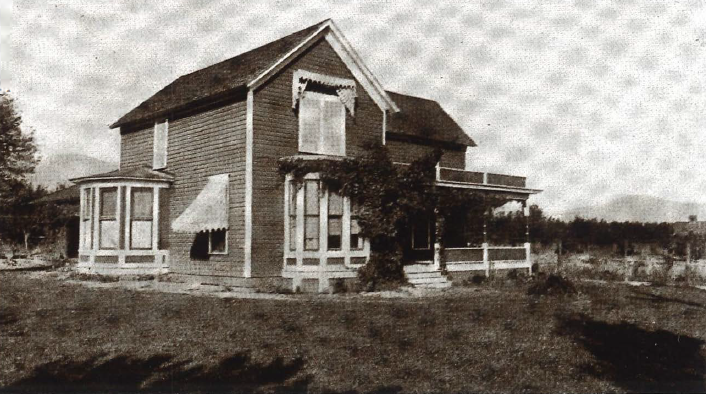
Source: Wenatchee Republic book, 1906. Dr. Colin Gilchrist used part of his home at Miller and Washington streets for a hospital.
St. Anthony’s Hospital
In 1915 two separate initiatives were begun by two religious organizations, the Catholics and the Methodists, to construct larger and more modern hospitals to meet the needs of the expanding community. (The population of Wenatchee precinct jumped from 4,021 in 1910 to 6,394 in 1920, according to the U.S. Census Bureau.) The Wenatchee General Hospital, now owned by Sister Mary Maloney, was in financial difficulties – so a “committee of gentlemen” from Wenatchee called upon the Catholic hierarchy in Seattle to request that a community of Sisters from Bellingham take over. On June 1, 1916, the Catholic Sisters of St. Joseph of Newark took over the lease on the Wenatchee General Hospital, and changed its name to St. Joseph’s. Sister Aloysius was appointed Superior; her staff of nurses consisted of Sisters Anthony, Clement, Antonius and Wenceslaus. It was clear that a larger facility would soon be needed.
Work began on a new hospital at the corner of Washington and Cleveland streets. This five-story “‘ building, built for $157,000, was dedicated on Oct. 7, 1922.

Source: Wenatchee Valley Museum & Cultural Center, #001-6-22. St. Anthony’s Hospital thrived for more than 40 years on Cleveland Street before moving to a new facility on Red Apple Road.
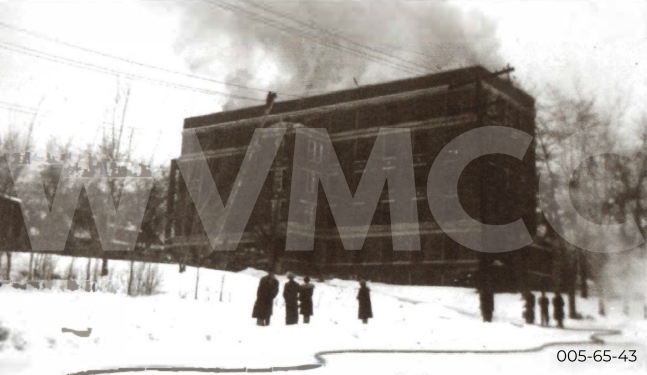
Source: Wenatchee Valley Museum & Cultural Center, #005-65-43. A fire at St. Anthony’s on January 7, 1943, forced the evacuation of 50 patients and 11 infants but no one was injured.
Sister Anthony was appointed Superior and the hospital’s name was again changed, this time to that of her patron saint. The hospital had 50 beds and was quite modern for its time. It was used until 1965, when a new St. Anthony’s Hospital opened on Red Apple Road at a site donated by Alcoa. The old St. Anthony’s became the Christopher House, an adult residential care facility.
The new St. Anthony’s Hospital was slightly larger than its predecessor, with 58 beds, and offered “dramatic advancement in medical facilities,” according to administrator Sister Jane Frances. The upper level housed the office, X-ray, surgery, emergency room, laboratory, physical therapy and patient rooms. On the lower floor were the kitchen, cafeteria, laundry, central supply, boiler room and storage areas. The surgery suite, among the most modern in Washington at the time, featured heart monitoring equipment with an electric pacemaker and defibrillator (3).
Deaconess Hospital
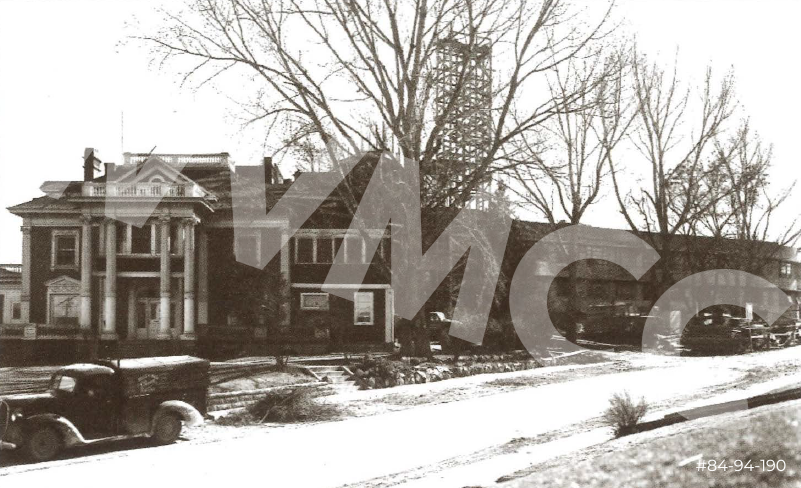
Source: Wenatchee Valley Museum and Cultural Center, #84-94-190. Construction at Deaconess in 1948 enlarged the hospital even further. The original hospital, once the Gellatly home, was used for nurses’ housing and classes.
A gift of $800 bequeathed to Rev. Jones of the First Methodist Church of Wenatchee from a dying railroad worker in 1915 inspired that church toward its own solution to Wenatchee’ s medical needs. Church members and others in the community formed the Central Washington Deaconess Hospital Association, electing former mayor and justice of the peace I.W. Reeves as president. Associated with this new hospital from its beginning were doctors J.H. Blake, C.S. Bridgham, Russell Congdon, J.E. Drury, Colin Gilchrist, T.H. Grosvenor, A.T. Kaupp, W.M. McCoy, W.G. Parker, M. Seibert and E.J. Widby.
The former home of Wenatchee mayor and businessman John Gellatly, at 312 Okanogan Street, served as the first Deaconess hospital. The three-story brick home had been built in 1908 and boasted the first hot water heating plant and the first lawn-sprinkling system in Wenatchee. As a hospital it had 25 beds, two operating rooms, sterilization scrub rooms, a laboratory and a laundry. The hospital remained an arm of what later was called United Methodist Church and its administrators, including longtime administrator Rev. Chester Finkbeiner, were usually Methodist ministers.
A four-story hospital addition behind the house was completed in 1923. The Gellatly home then became the home of the Deaconess School of Nurses. The newly enlarged Deaconess Hospital expanded bed capacity to 50 and provided improved surgical, laboratory and X-ray facilities. It (along with St. Anthony’s Hospital) met the needs of the community until 1948 when another fundraising drive, along with a federal grant and a mortgage, enabled construction of another modern, three-story addition. Deaconess now could care for 100 patients, or 125 in an emergency. The facility rose to the challenge of Wenatchee’s 1952 polio epidemic, which sent 148 people to the hospital between June and November and raised awareness of its new physical therapy department. One highlight was a large stainless steel tank in which patients were submerged in warm, bubbly water that made it easier and less painful for them to exercise (4).
Community leaders launched a third fundraising campaign in 1962. This netted enough money for Deaconess to add a new surgical suite that included four major operating rooms, a recovery room and a fracture room. It also paid for a new physical therapy department, a modern laboratory, a separate pediatrics ward for children, improved laundry facility and renovations to the X-ray department. Air conditioning was even installed in the 1948 patient wing. Deaconess Hospital served 14,133 patients in 1963 – a huge jump from 168 in 1915! (5)
Leavenworth hospitals
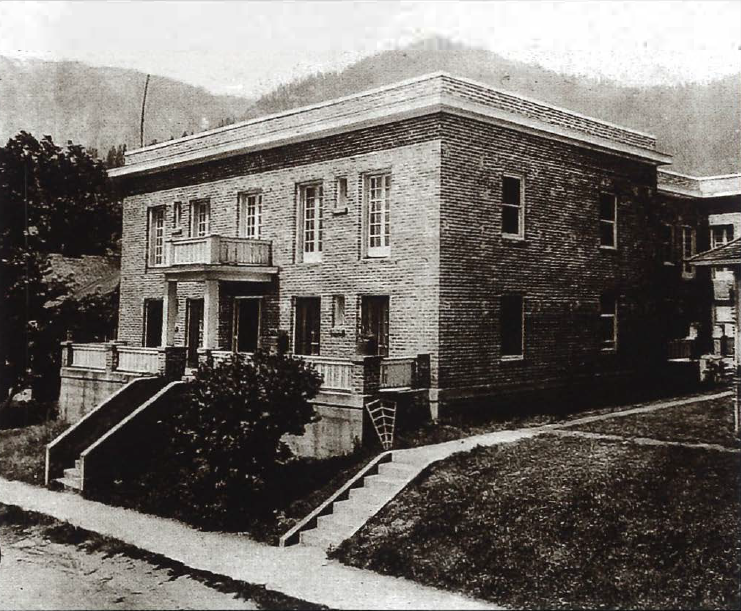
Source: Rena Stroup Collection. Dr. Albert Lessing opened the Cascade Sanitarium on Main Street in Leavenworth in 1923.
Meanwhile, in Leavenworth, Dr. J. Stillson Judah built another small hospital to supplement the Lamb-Davis hospital now operated by Dr. Elmer. Judah practiced in Leavenworth from 1910 to 1920; his hospital beds were constantly full, especially during the 1918 wave of Spanish influenza. “From January 1st of the fiscal year this little hospital has successfully cared for 36 laparotomies (incisions into the abdomen) and other major operations, 96 medical cases, 24 obstetrical cases, 50 severe accident cases from the railroad, mills and automobile accidents, and scarcely a day passing that one or more accident cases are not brought to the hospital (6).”
Judah sold his practice to Dr. Cox, who in turn was replaced by Dr. Albert Lessing in 1921. Lessing built the town’s first full-sized hospital, called Cascade Sanitarium, on the corner of Eighth and Main streets in 1923. The 26- bed facility kept busy handling the medical care for railroad workers building the eight-mile tunnel under Stevens Pass. When Lessing moved back East in 1929, Dr. Howard Hopkins took over his practice and hospital.
Leavenworth by now had undergone some major changes. The sawmill had shut down, and Great Northern Railway had transferred its division headquarters to Wenatchee and rerouted the tracks away from downtown and treacherous Tumwater Canyon to the Chumstick Valley. No longer did Leavenworth offer easy employment to transient men. Full-time residents and families, however, kept the town alive and the sanatorium full. A young Dr. Marvin Speer, assigned to a Civilian Conservation Corps camp in Chelan in the mid-1930s, was recruited to help Dr. Hopkins with a serious outbreak of pneumonia and ended up practicing in Leavenworth for 45 years.
Other doctors came and went, the town’s population began to grow again with the transformation to a tourist-attracting Bavarian Village, and the old hospital failed to pass state inspection. A bond to create a hospital district and construct a new hospital was passed with overwhelming support in 1970. Ors. Speer, Vic Gehring and Jack Koenig were the primary physicians for Cascade General Hospital, which was built on a city block between Main, Commercial, Eighth and Ninth streets. Thanks to another successful bond issue passed by Upper Wenatchee Valley residents, that hospital and its adjacent clinic are undergoing a major expansion at the present time.
Central Washington Hospital
From 1915 to 1965, Wenatchee had had two modern, fun-size hospitals. However, during the next ten years, both Deaconness and St. Anthony’s hospitals came to realize this was no longer economically feasible. Improvements in medical technology reduced the patient’s length of stay, resulting in more empty beds; Wenatchee’s population had ceased to expand; and the increasing number of local, state and federal regulations affected hospital operations. An agreement was reached in 1974 where Deaconess would purchase St. Anthony’s and the two would operate under the corporate name of Central Washington Health Services Association, Administration, housekeeping, radiology, lab, nursing and medical staffs were consolidated. Some functions, such as obstetrics, were centralized at St. Anthony’s (the name was changed to Rosewood) and others, such as the emergency room, were at Deaconess.
The logical next step was to truly create one comprehensive hospital for Wenatchee. The largest fund drive in the valley’s history and public support for the sale of bonds made it possible to invest $12 million in a first-class medical facility that serves all of North Central Washington. The much-renovated Deaconess hospital on Okanogan Street was closed in 1978 and all operations transferred to Rosewood. The hospital was enlarged to a campus of several interconnected buildings with color-coded entrances that accommodated 141 beds and its name changed to Central Washington Hospital. In 2000 it opened its award-winning Heart Center, built in cooperation with the Wenatchee Valley Clinic. CWH is currently undergoing a $150 million expansion and remodel: a five-story patient tower that will contain 174 patient rooms, as well as a parking structure for 200 vehicles.
Wenatchee now has two general hospitals. The Leavenworth hospital, now called Cascade Medical Center, opened a 16-bed satellite hospital in July 1997 on the campus of the Wenatchee Valley Clinic. Four years later the clinic (now Wenatchee Valley Medical Center) received permission from the state to purchase and expand this hospital to 21 beds. It is now called the Wenatchee Valley Hospital.
Editor’s note: Two articles by retired Dr. Robert J. Hoxsey on the history of the Wenatchee Valley Medical Center were published in The Confluence in the summer and fall of 1989. Jeanette Marantos researched and the Wenatchee Valley Museum published a comprehensive history of WVMC in November 1999 titled “Wenatchee Valley Clinic: The history of a thriving anomaly.” All of these publications are available at the museum.
ENDNOTES
- Saddlebags to Scanners: The First 100 Years of Medicine in Washington State, “Chelan-Douglas County,” Robert Hoxsey, M.D., 1989.
- Wenatchee Daily World, July 19, 1962.
- Ibid., Sept. 11, 1966.
- Jeanette Marantos and Steven B. Smith, historical display on walls at entrance to Central Washington Hospital admitting room.
- Central Washington Hospital 50th anniversary packet, May 1965.
- Leavenworth Echo, Oct. 24, 1919.
This story was originally published in Confluence Magazine in the Fall edition of 2010. In an effort to preserve these stories, the Wenatchee Valley Museum and Cultural Center will be posting these stories on the museum’s official blog.
Become a member to get a free copy of Confluence Magazine. Learn more about how to become a member here!
Interested in keeping a photo copy? Learn more about our photo archives and request your own copy below.

